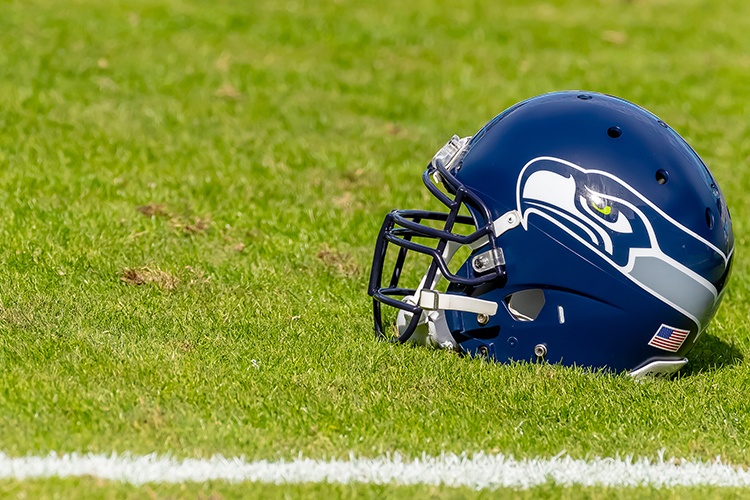Football fans instantly recognize the stylized bird and blue colors of the Seattle Seahawks logo. The Seahawks won their first Super Bowl in 2014, and that gave even more people the chance to wonder what that bird was.

How the Team Started
In 1974, the city of Seattle received word that it would soon host its own professional football team. The announcement came as part of a series of expansions that followed the 1970 merger of the National Football League (NFL) and American Football League (AFL).
Naming the Team
The team didn’t have a name yet, but that soon changed. In 1975, general manager John Thompson announced a naming contest for the team. Some suggestions the team received were the Mariners, Evergreens, Olympics and Sockeyes. Thompson chose the name “Seahawk” because he said it made him think of a “tough, fish-eating bird.”
Local artist Marvin Oliver submitted his design for the logo, and the team adopted it in 1976. Inspired by Native American imagery, the bird had a distinctly angry, aggressive frown. The team chose deep blue and green as its logo and uniform colors. Those colors reflect the state’s Pacific Ocean coastline and its vast forests.
Color Changes
The official team logo has changed little in the past 40 years. The original logo lasted unchanged until 2001. In that year, a graphic design team updated the logo to make it look more modern.
The 2001 logo is a slimmer and leaner than the earlier version. Instead of bright blue and green, the logo colors are now dark blue, pale blue and green. The overall effect is simpler and more striking. The bird also has a more pronounced frown.
In 2016, Seattle updated the bird image again. In this version, the colors are a muted gray and blue. The teams’ official uniforms reflected these color changes.
Alternate Logos
The Seahawks have experimented with alternative logos for special occasions.
In 2011, the team created a large, highly detailed image of a seahawk coming in for a catch. The bird had long, unfurled wings and huge talons.
In 2017, the team unveiled a logo that depicted the famous bird as seen from the front. The team’s official Twitter announcement said it was, “For everyone who’s ever wondered what it would be like to stand face to beak with a Seahawk.”
Reactions to the logo were mixed at best. Some comments on Twitter compared the Seahawk face to the face of the character Mr. Burns on The Simpsons. Others though it looked like an emu. The team, however, made the logo available on hats and hoodies for those who liked it.
Read more: How to trademark a logo.
What Is a Seahawk?
There is no actual bird that’s called a seahawk or sea hawk. It’s not the name of any known species.
According to the Audubon Society, the word “seahawk” might be a nickname for a skua or an osprey. A skua is a waterfowl known for its ferocity. Skuas will fight and kill other birds over a meal.
Is It an Osprey?
Some people refer to ospreys as river hawks or sea hawks. Is the Seattle logo an osprey? The shape and colors would show it’s not. Ospreys have round beaks that are the opposite of the seahawk logo’s long, streamlined beak. They have white, black and gray feathers, and the football team’s colors are blue and green.
It’s also illegal to use an osprey for any commercial purpose because they’re endangered. That’s why the Seahawks’ live mascot is an augur hawk.
It’s Actually a Stylized Eagle
The Seahawks bird is a design that recalls the Native American symbol of the thunderbird, which is a large, mythological bird that resembles an eagle.
The thunderbird is one of the most important spirits in Native American beliefs. The design on the helmet closely resembles the look of a classic thunderbird.
Honoring Native Art
This symbol is a nod to the state’s many Native American tribes. As the Burke Museum in Seattle points out, the logo strongly resembles a Kwakwaka’wakw (pronounced KWA-kwuh-kyuh-wakw) eagle mask first depicted in a 1950 book, Art of the Northwest Coast Indians.
Use of Native imagery can be highly controversial. Teams that use Native American imagery or names have faced enormous criticism. In recent years, both the Washington Redskins and the Cleveland Indians have announced they are changing their names.
Sign of Respect
It’s different in Seattle, however, and that may be because of the team’s active involvement with the Native American community.
In an article on SportsCasting, Nella Vann writes that, “The Pacific Northwest is home to many Native Americans known for their beautiful artwork and innovations. The Seahawks team counts many fans among them and is a welcome, active part of the local Native community.”
Among Seattle fans, the logo is a sign of respect for Native artistry. It is an acknowledgement of a shared history.
The Original Mask Surfaces
In 2015, researchers at the Burke Museum in Seattle discovered that the original mask from that 1950 book still existed. It was at the Hudson Museum in Maine. The museum turned to local groups and corporate sponsors to raise the money to bring the mask to Seattle. It arrived a few months later.
After a Native welcoming cemetery, the mask was displayed as part of a temporary exhibit titled, “Here and Now: Native Artists Inspired.” According to the museum, the mask had clearly been used in important rituals and celebrations. The museum described the mask as the inspiration for the team’s logo.
Flying Above Controversy
It’s clear the Seahawks have avoided controversy by using Native imagery respectfully and in a way that honors its Native fans. Unlike some other teams, the Seahawks won’t have to face the prospect of changing their name or logo.

